DISCLAIMER
the content of these galleries is a private property
neither the text nor the pictures may be republished, nor used for any purpose, without the author's permission
special thanks to Jeff Hopewell, whose
knowledge of Ganjifa
has been a precious reference in the compilation of this gallery
(skip the historical notes)
HISTORICAL NOTES
Despite the origin of Indian pastimes, such as the board game Ashtapada
(renamed Chaturanga, "the four sides", in the 5th century AD),
is lost in the mists of time, in this land the golden age of playing cards was to come
much later, during the 16th century, by the time of the Mughals (or Moguls), a
Muslim dynasty from central Asia, great fanciers of Ganjifa.
The leading theory about Ganjifa is that the pattern was created in Persia, likely
under the influence of playing cards from the East (probably money-suited decks), and that they
were taken to India by the time of the Mughal emperors. |
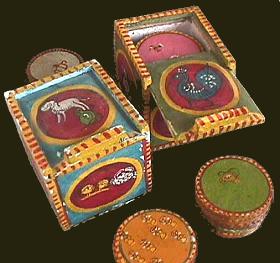 |
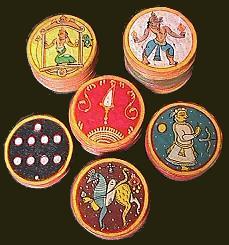 |
However, traces of similar and much earlier (pre-Mughal) cards may be found
in the local oral tradition. They were called Kridapatram,
whose meaning is more or less "painted rags for playing", and the composition of the deck
was apparently based upon 12: in fact, this was the number of suits, each of which was made of this
same number of subjects, and used signs such as horses, elephants, men, and the like.
Basically, they were an early version of the Dasâvatâra pattern described in page 2,
but some decks were inspired by the epic Mahâbhârata, and some others had fewer suits
(8, or 10). It is locally said that by the time of the Mughals these cards had already been
in use for several centuries. Many details about the Kridapatram cards, though, remain
a mystery, as well as their same existence, not being mentioned by any written source
prior to the 16th century. |
The Islâm had already established contacts with the Hindu world
since the 13th century, when Muslim people coming from an area corresponding to modern Afghanistan
had expanded their dominions towards Punjab, and other north-western
parts of India. They were descendants of the Turkic populations who had invaded
Persia in the 11th century, and some 200 years later had been
chased out of the same land by the Mongols. These people maintained elements of their Turkish
heritage, yet they spoke Farsi (Persian), and also borrowed several cultural
aspects from the Mongols. The same name of the Mughal dynasty, in fact, in their own language
meant "Mongol". |
|

geographic origin of the Mughal dynasty
|
In 1398 the conqueror Timur Lenk (Tamerlane), had succeeded
in subduing many northern parts of the Indian subcontinent, though not establishing a real
dominion. This only happened in the early 1500s, when Bâbur (one of Timur's descendants, but whose family
tree also included the famous Mongol leader Genghis Khan) repeated his ancestor's feats,
conquering a large part of north-western India, thus founding the Mughal empire.
From 1556 to 1605 one of his successors, Akbar, completed this campaign, expanding the
empire's boundary eastwards, as far as the Gulf of Bengal. |
 |
The Mughals were Muslims, but they never enforced the observation
of the Islâmic codes, as other conquerors had in the past; under their reign, the Hindus were left free to use their language, maintain
their customs and follow their lifestyle.
It is during this period that Ganjifa cards flourished, at first
only at court, where rich sets made of ivory or tortoise shell inlaid with precious stones were
used (called darbar kalam), but later on the game also
spread among the common people, who used cheaper sets made from wood, palm
leaf, pasteboard, and various other unexpensive materials (the so-called
bazâr kalam). |
In 1648, under the reign of Aurangzeb, strict Islamic laws were
introduced again, causing revolts in several parts of the empire; this caused the loss of
some of the territories by the hand of the rebels.
The following rulers were not strong enough to bring back the Mughal empire to the original
splendour. During the first half of the 18th century it began to
break up, and only 50 years later the few remaining parts still under Mughal control were
taken by Marâthâ (an independent Hindu state, that had grown stronger and
had become an empire itself), and then in 1803 by the British. |
 |

GANJIFA OR GÂNJAPHÂ
 |
The earliest reference about the cards known as Ganjifa
is an Indian chronicle dating back to the early 16th century; the text, a biography
of Bâbur, contains a description of the deck's suits, mentioning how the same monarch
enjoyed playing the game with his daughter, and even gave a set to a friend as a gift.
The name of these cards comes from the Farsi word  ganjifeh ganjifeh, whose meaning is
"playing card". Such foreign name is due to the Persian origin of this pastime,
much earlier than the 1500s, as previously said, born as a development of cards
imported from other lands, likely Central Asia or Asia Minor (this topic is discussed more in depth further
down this page). |
|
According to Culin, the word
ganjifa may have been created by
blending the local
 ganj
ganj
("treasure") with the Chinese expression
 chi pai
chi pai
("paper cards"); in fact, these cards almost certainly have an Oriental ancestor. But
the development into the newborn
Ganjifa pattern brought more remarkable changes
than any other type of cards ever did: the number of suits was considerably increased, their
signs were changed, and even the traditional rectangular shape was rounded off, making
these the only circular cards known in the world among regional patterns. Actually, also
rectangular
Ganjifa packs are known to exist, dating back to the 19th century
or earlier, especially in parts of the country where a Western cultural contamination
(Portuguese, Dutch) was likely, as in the south; but between the two
shapes, by tradition, the round one is more consolidated.

6 of Kurma (the suit sign is a turtle) and 10 of Narasimha
(the suit sign is a chakra or decorated disc),
from a Dasavatara Ganjifa deck |
Despite the many changes, the general structure of any
Ganjifa deck is not really different from other kinds of pattern. The suits are
always made of twelve subjects, whose backgrounds are coloured. Their values include pip
cards running from 1 (or ace) to 10, and two courts: a minister (or counsellor) and a king.
The pips are small suit signs, more or less stylized, arranged in patterns of various
fashion, a free choice of the artist who painted the deck, though often influenced
by the regional trend.
|
|
The geographic origin of a deck also affects its background colours, one different for
each suit, thus alternative names for Ganjifa decks, according to how many suits
they have, are atharangi ("eight colours"),
navarangi ("nine colours"),
dasarangi ("ten colours"),
baraharangi ("twelve colours"),
and so on. |
|
|
In patterns with more than eight suits, some colours
may appear similar, but in this case the rim, clearly different, provides an easy reference.
Ganjifa packs that come from the same area not only
have similar illustrations but matching backgrounds too, differing from those of
decks made elsewhere.
The use of different background colours for identifying the suits
of the deck was once found also in the other variety of traditional
Persian cards, the As-Nas, now extinct.
The names of the two court cards are either in Farsi, the official language of
the Mughals, or in Sankrit, anciently spoken by the Hindus, or in Hindi (modern language),
as shown in the table on the right.
|
|
|
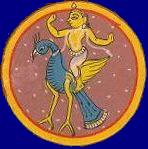 |
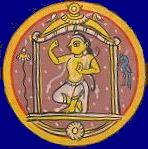 |
|
|
|
| Farsi: |
 vazîr / wazîr vazîr / wazîr |
 shâh shâh |
| Sanskrit: |
 pradhân pradhân |
 nrpah nrpah |
| Hindi: |
 mantrî mantrî |
 râjâ râjâ |
the court cards shown above are from the suit of Kartikkeya (god of war)
whose sign is a peacock; they come from a Dasavatara Ganjifa deck |
Their illustrations depict human figures and incarnations of many Indian divinities,
posing in different attitudes, that change in accordance with the pattern of the deck and
with the regional custom.
In the state of Orissa (eastern India), where the sample cards shown in this
page come from, the suit signs are more stylized than the ones found in the rest
of the country, up to the point of being no longer recognizable, almost abstract.
However, besides the background colours and the choice of the suits, some stylistic differences
can be found within the same state, from city to city.
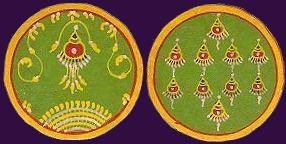
1 and 10 of Changa ("harp") from a Mughal Ganjifa deck:
what the sign represents is no longer recognizable |
In play, the natural ordering of the pip card values (1 the lowest, 10 the highest)
is followed by only half of the suits, while the cards of the other suits are given an
opposite ranking (1 is the highest, 10 is the lowest). The suits in the first group are
said to be bishbar ("strong"), while the ones with reversed
ranks are called kambar ("weak"); alternative names used in
some central parts of the country are dahele-bandibaji ("10-high suits") and
ekka-bandibaji ("1-high suits"). |
Besides their graphic features, what is probably the most
interesting peculiarity of any Ganjifa deck is that these cards are still hand-made
and hand-painted by skilled craftsmen, known as chitrakara, whose workshops are sometimes
specialized in this form of art. Therefore, each deck is a truly unique item.
The backs are either plain or have minor decorations by the rim. |

Ganjifa card backs |
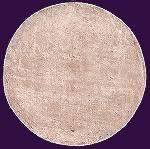
blank disc, before being painted |
Today ganjifa cards are made of layers of pressed paper, but in Orissa cloth is still used.
At first, sheets are soaked with glue made from tamarind seeds; when dry, by using a mold
the starched cloth is cut into discs, two of which are glued together to make individual
cards; a paste made from chalk is then applied to make the surface even, and the deck is
finally painted.
Some decks are housed in a wooden box or case, often decorated with themes consistent
with the pack's pattern (see the first picture of this page). |

chitrakara Jayadev Moharana, author of
the Dasavatara cards shown in this gallery
(by courtesy of Jeff Hopewell) |
Attempts to print Ganjifa decks have been made during the 20th century,
without proving very successful, and therefore never replacing the traditional craft.
Regrettably, due to the lack of request, during the past decades the making of these decks,
once a common activity throughout India, has considerably subsided, and is now no longer very
common. The game too is certainly endangered, but not extinct, and especially in the state of
Orissa the locals are still known to play with
Ganjifa sets.
|
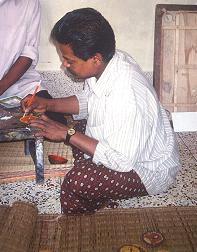
chitrakara Kalu Charan Bariki, author
of the Mughal cards shown in this gallery
(by courtesy of Jeff Hopewell) |
RELATIONS BETWEEN GANJIFA AND OTHER EARLY GAMES
To trace the net of connections between Ganjifa (or Kridapatram) and
other forms of pastime which Indian cards may have sprung from and, maybe, given origin to, is a
complicated task, due to the many uncertain and missing pieces of information,
and to the different cultural relations this land was subject to in time.
Among the latter, one of the earliest ones is Buddhism, that spread from Northern India
towards many different parts of China; this may have established a relationship
through which playing cards could have been introduced in India, provided that they already
existed in Chinese lands at such an early stage: this is suspected by some scholars, but no
evidence has ever been found. |
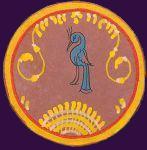
1 of Kartikkeya
from a Dasavatara Ganjifa deck
|
Culin's interpretation of the word
ganjifa as "treasure paper cards", if correct,
would provide two more elements in favour of an origin from Chinese money-suited decks,
since the suit signs of the latter system are quite evidently symbols of money, i.e. the "treasure" - some scholars
even maintain that in China cards once represented an actual form of tender - and because
they are the only type of deck which, in the homeland's own language, is referred to as
"paper cards", to distinguish them from playing tiles (see the historical notes in the
Chinese gallery
for further details).
Also the ancient native board game Chaturanga, which later developed into its Persian form
Shatranj (still in use), has been claimed as a possible source of inspiration for the Indian round cards.
This was a sort of race game, in which pieces could also fight each other.
It required counters of different rank - the highest was the
râjâ - and a long die with four sides.
Its name is Sanskrit,  catur catur ("four")
and  anga anga ("part, side"),
referring to the four corps of the Indian army: elephant-riders, cavalry, foot-soldiers and
charioteers (later on turned into "ships"); with the exception of the latter, the remaining three were also among the
suits of the Kridapatram cards. |
opening arrangement of pieces in Chaturanga

(adapted, from R.C.Bell) |
However, the concept of
Chaturanga, whose aim is to mimic a war, is much similar
to modern chess variants (Western chess, Chinese chess, etc.) than to
Ganjifa games,
the closest possible reference to
Kridapatram, whose rules
were not recorded by any written source.
chronology of the evolution of early cards
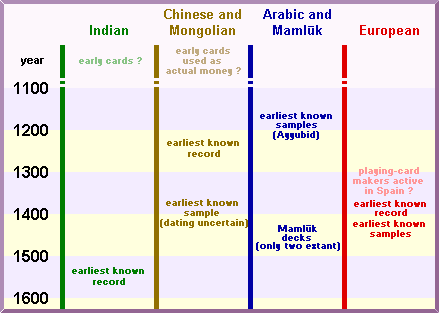 |
Indian cards were used for trick games, two of which are known as Ekrang and
Hamrang (see John McLeod's Games played with Ganjifa), the
same type of pastime which the early European tarots were used for, now replaced by the regional
patterns that sprang from them.
Also the Mamlûk decks were likely used for
similar games: the quality of the surviving cards suggests that they were made for players
of high social rank, who very unlikely gambled for money; on top of this, gambling is a
practice frowned upon by the Islâm. |
|
The use of inverted ranks for different suits appears to be another common feature. It
is found in some Chinese games, as well as in some European ones of ancient origin; we cannot tell wether this
also occurred in games played by the Mamlûks, but since it is commonly accepted that the Arabic
decks were the base upon which European patterns were created, we may reasonably believe
that the dual ranking criterium was adopted everywhere.
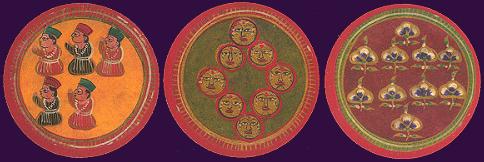
Mughal Ganjifa cards, late 18th century
(replica of an original from the Fournier Museum in Alava-Gasteiz, Spain):
the suits shown are (from the left) Servants, Gold Coins, Flowers
Similarities may also be sought between the Indian suit signs (particularly the ones
found in Dasâvatâra sets) and those of Mamlûk decks; despite the quantitative
difference on the two sides - twelve suits versus the "usual" four, respectively - the
presence among the Ganjifa signs of Coins (two different), Water-jugs, Swords and Clubs almost matches the Coins, Cups, Swords and Polo-sticks which form the other system.
The structure of the Indian sets includes court cards, a further
element in common with Mamlûk decks, but the latter had three in
each suit while Ganjifa has only two; furthermore, due to the
Islamic codes, the Arabic subjects were only featured
as the written names of their rank and suit, while the Indian personages are fully portrayed. |
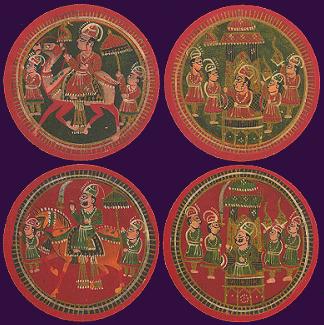
Mughal Ganjifa, late 18th century:
wazîr and shâh (courts) of the suits of Harps and Swords |
Chinese money-suited patterns, instead, have no courts, although in some games
their honour cards may be added to the highest or to the lowest pip cards of given suits,
in order to form a longer sequence, thus acting de facto as courts.
Therefore, the Arabic cards and the Indian ones appear indeed
related, yet not too closely. A reason for this may be that such connection was not direct,
but filtered through Persia, both a geographic and
cultural pivot wedged among the Arabic, Central Asian and Indian worlds.
More Ganjifa patterns may be seen in the following pages of the I.P.C.S.'s website:
Sawantwadi Dasavatara
Sawantwadi Moghul
Nossam Dasavatara.
Another page from the same website, Sawantwadi
French Suited Pattern, shows interesting samples of "hybrids" that blend Ganjifa with
European decks. The cards are round, the graphic style is Indian, but the suits are French.
Such decks came into use in limited areas on the country's western coast, following the
trading routes that came particularly from Portugal and from the Netherlands.
Also "hybrid" patterns with Spanish (Portuguese) suits were produced, though
much scarcer than the ones with French suits.
OTHER GALLERIES






















or back to

INTRODUCTION
AND HISTORY
|

MULTI-LANGUAGE
GLOSSARY |

THE FOOL &
THE JOKER |

INDEX
TABLE |

REGIONAL
GAMES |

PLAYING CARD
LINKS |